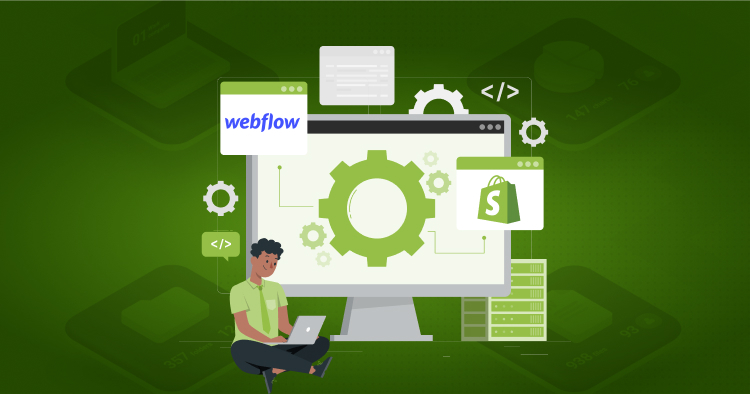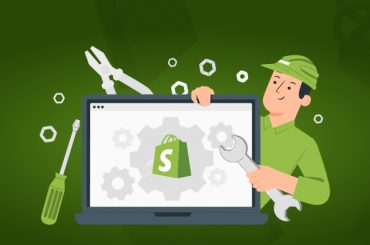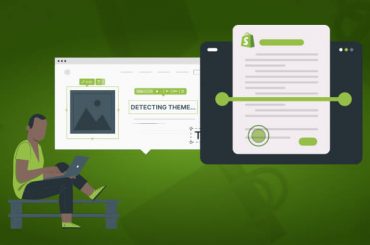Migrating from Webflow to Shopify, Best Guide 2024
Last Updated | January 8, 2024
Table of Contents
Brief Overview of Webflow and Shopify
Are you thinking of launching an online business but struggling to choose the right platform? Webflow and Shopify are two of the most popular website builders that offer their own advantages depending on your needs. Shopify is a turnkey e-commerce platform used by over a million online businesses worldwide. It has a user-friendly interface, a large app ecosystem, and powerful tools to manage orders and payments. On the other hand, Webflow is a drag-and-drop website builder that offers complete creative control over your website design, making it perfect for companies that prioritize customization and visual aesthetics. Both Webflow and Shopify excel at different aspects of website building, which makes it important to consider what you’re looking for before deciding which one to use.
Why Migrate from Webflow to Shopify?
Migrating from Webflow to Shopify can be a strategic decision for various reasons, depending on your specific business needs and goals. Both platforms offer unique features and capabilities, and the decision to migrate should be based on your particular circumstances. Here are some common reasons why businesses consider migrating from Webflow to Shopify:
- E-commerce Focus: Shopify is primarily an e-commerce platform, whereas Webflow is more versatile and can be used for various types of websites. If your business’s primary focus is selling products online, Shopify provides specialized e-commerce features that can make managing your store easier and more efficient.
- Scalability: Shopify is known for its scalability. As your business grows, you may find that Shopify offers more robust options for handling larger inventories, more complex product variants, and higher order volumes. This scalability can help you accommodate growth without needing to switch platforms again.
- App Ecosystem: Shopify has a vast ecosystem of third-party apps and integrations that can extend the functionality of your online store. Whether you need advanced marketing tools, customer relationship management (CRM) software, or specialized shipping and fulfillment solutions, you’ll find many options in the Shopify App development Store.
- Payment Options: Shopify provides a wide range of payment options, including its own payment gateway (Shopify Payments) as well as support for numerous third-party payment processors. This flexibility can be important for international businesses or those with specific payment requirements.
- Security and Compliance: Shopify places a strong emphasis on security and compliance, including PCI DSS compliance for handling credit card data. This can be crucial for building trust with customers and ensuring the security of their financial information.
- Mobile Optimization: Shopify offers mobile-responsive themes and a mobile app, making it easier to create a seamless shopping experience for customers on mobile devices. With the growing importance of mobile commerce, this can be a significant advantage.
- Marketing and SEO: Shopify provides built-in SEO tools and features that can help improve your store.
Read Also Shopify To Shopify Migration
Preparation before Migration
Backup Your Webflow Data Before embarking on migration; ensure all your Webflow data is backed up. This includes your website design, products, customer data, and other crucial information. Having a backup will provide a safety net in case of unforeseen issues during migration.
Create a Shopify Account Set up a new Shopify account if you do not already have one. Choose a suitable plan based on your business needs and budget.
Understand the Shopify Platform Familiarize yourself with Shopify’s interface and features. There are numerous guides and tutorials available online to help you get started.
Read Also Square to Shopify Migration
Data Migration
Migrating Products Utilize a migration tool or hire a professional to transfer your product data from Webflow to Shopify. This includes product descriptions, images, prices, SKUs, and other relevant information.
Migrating Customers Similar to product data, customer data such as names, emails, and purchase history should be transferred securely.
Migrating Orders Transfer all order data to maintain accurate records and ensure a smooth transition for your customers.
Migrating Blog Posts If you have a blog on Webflow, migrate all posts, images, and metadata to Shopify to preserve your SEO rankings and keep your content accessible.
Design and Customization
Theme Development and Customization Select a Shopify theme that reflects your brand’s identity. Customize it to ensure consistency with your previous design on Webflow.
App Installation for Extended Functionality Explores Shopify’s app store to find apps that can extend your store’s functionality and improve your customers’ shopping experience.
Setting Up Your Store’s Navigation Organize your store’s navigation to make it easy for customers to find what they’re looking for.
Read Also Etsy To Shopify Migration
Testing Your Shopify Store
Functionality Testing Test all features to ensure they work as expected. This includes checkout processes, payment gateways, and other crucial functionalities.
Performance Testing Ensure your Shopify store loads quickly and performs well under different conditions.
Cross-browser and Mobile Testing Test your store on various browsers and mobile devices to ensure compatibility and responsiveness.
Read Also Migrate OpenCart to Shopify
Launching Your Shopify Store
Setting Up Redirects Set up redirects from your old Webflow URLs to the new Shopify URLs to maintain SEO rankings and provide a seamless transition for your customers.
Announcing the Migration to Your Customers Communicate with your customers about the migration, and let them know what to expect.
Monitoring and Analytics Setup Install monitoring and analytics tools to track your store’s performance post-migration.
Post-Migration
SEO Optimization Post-Migration Review and optimize your SEO settings to ensure your store remains visible and competitive in search rankings.
Ongoing Maintenance and Support Keep your Shopify store updated, and seek professional support if needed to address any issues that arise post-migration.
Evaluating Your Store’s Performance Regularly evaluate your store’s performance and make necessary adjustments to continually improve the shopping experience for your customers.
Comparison between Webflow vs. Shopify
| Aspect | Webflow | Shopify |
|---|---|---|
| Purpose | Versatile web design and development | Dedicated e-commerce platform |
| Ease of Use | Visual drag-and-drop interface | User-friendly interface for non-technical users |
| Customization | Highly customizable | Customization within templates/themes |
| E-commerce Features | Limited, better for simpler needs | Extensive features, ideal for all business sizes |
| Hosting and Security | Offers hosting, SSL certificates | Handles hosting and security |
| Cost | Various pricing plans, including a free plan | Pricing tiers, cost depends on needs |
| Scalability | Suitable for small to medium-sized stores | Suitable for businesses of all sizes |
This table provides a concise overview of the key differences between Webflow and Shopify across various aspects.
Conclusion
Transitioning from Webflow to Shopify can be a smooth process when planned and executed correctly. Following the steps outlined in this guide will help ensure a successful migration to Shopify and set the foundation for your eCommerce business to flourish on the Shopify platform.
Read Also Migrate From Volusion To Shopify
Frequently Asked Questions (FAQs)
Is migrating from Webflow to Shopify the right decision?
The decision to migrate from Webflow to Shopify largely depends on your specific business needs. Shopify is a robust eCommerce platform with a user-friendly interface, making it a great choice for those looking to grow an online store with a range of integrated sales channels and an extensive app ecosystem. However, if website design and customization are your priorities, Webflow might be a better fit. It’s advisable to assess your business goals, technical skills, and the kind of user experience you aim to offer before making a decision.
How long will the migration process take?
The duration of the migration process can vary significantly depending on the complexity of your Webflow site, the amount of data to be migrated, and the level of customization required on your new Shopify store. It could take anywhere from a few days to several weeks. Planning and preparing adequately, as well as considering the assistance of professionals or utilizing migration tools, can expedite the process.
What are some common challenges faced during migration?
Migration from one platform to another can come with several challenges. Some common issues include:
- Data Loss: The risk of losing data during migration is a significant concern. It’s crucial to have a complete backup of your Webflow data before beginning the migration process.
- SEO Rankings: Your site’s SEO rankings might be affected if the migration isn’t handled correctly. Ensuring that URLs are redirected properly and metadata is transferred accurately is crucial to maintaining your search engine rankings.
- Design and Customization: Achieving the same design and customization on Shopify as you had on Webflow may be challenging due to the differences in the platform’s design capabilities and coding languages.
- Functionality Gaps: There may be certain features or functionalities in Webflow that you might not find in Shopify or may require additional apps or custom development.
- Cost: The cost of migration can also be a challenge, especially if you require professional help or need to purchase new themes, apps, or custom developments.
Being aware of these challenges beforehand and preparing for them can help ensure a smoother migration process.









